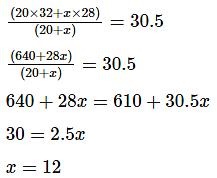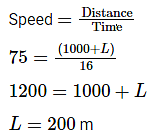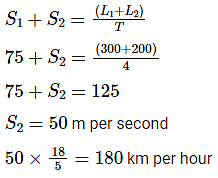Goa PCS Pre-Screening Mock Test- 4 - GPSC (Goa) MCQ
30 Questions MCQ Test GPSC (Goa) Mock Test Series 2024 - Goa PCS Pre-Screening Mock Test- 4
Directions : Study the information and answer the following questions:
In a certain code language
"believe these change will" is coded as “ 12@M 1@H 5#T 12#W”
"board before his departure" is coded as “1#S 6@S 19#J 16#S”
"market both side trading" is coded as “ 1#O 4@E 20@U 18@F”
Q. What is the code for ‘urgently'?
Directions : Study the information and answer the following questions:
In a certain code language
"believe these change will" is coded as “ 12@M 1@H 5#T 12#W”
"board before his departure" is coded as “1#S 6@S 19#J 16#S”
"market both side trading" is coded as “ 1#O 4@E 20@U 18@F”
Q. What is the code for ‘confidence'?
| 1 Crore+ students have signed up on EduRev. Have you? Download the App |
Directions : Study the information and answer the following questions:
In a certain code language
"believe these change will" is coded as “ 12@M 1@H 5#T 12#W”
"board before his departure" is coded as “1#S 6@S 19#J 16#S”
"market both side trading" is coded as “ 1#O 4@E 20@U 18@F”
Q. What is the code for ‘return'?
Directions : Study the information and answer the following questions:
In a certain code language
"believe these change will" is coded as “ 12@M 1@H 5#T 12#W”
"board before his departure" is coded as “1#S 6@S 19#J 16#S”
"market both side trading" is coded as “ 1#O 4@E 20@U 18@F”
Q. What is the code for ‘between'?
Directions : Study the information and answer the following questions:
In a certain code language
"believe these change will" is coded as “ 12@M 1@H 5#T 12#W”
"board before his departure" is coded as “1#S 6@S 19#J 16#S”
"market both side trading" is coded as “ 1#O 4@E 20@U 18@F”
Q. What is the code for ‘bankers'?
Directions (1-5): In each of these questions the symbols &, @, #, % and $ are used with different meanings as follows.
I. ‘P & Q’ means ‘P is not smaller than Q’.
II. ‘P @ Q’ means ‘P is not greater than Q’.
III. ‘P # Q’ means ‘P is neither smaller than nor greater than Q’.
IV. ‘P % Q’ means ‘P is neither smaller than nor equal to Q’.
V. ‘P $ Q’ means ‘P is neither greater than nor equal to Q’.
In each question, four statements showing relationships have been given, which are followed by four conclusions I, II, III and IV. Assuming that the given statements are true, find out which conclusion(s) is/are definitely true.
Q. Statements: M@N, N$O, O&P, P#Q
Conclusions:
I. Q$O
II. Q@O
III. M$O
IV. Q#M
Directions: In each of these questions the symbols &, @, #, % and $ are used with different meanings as follows.
I. ‘P & Q’ means ‘P is not smaller than Q’.
II. ‘P @ Q’ means ‘P is not greater than Q’.
III. ‘P # Q’ means ‘P is neither smaller than nor greater than Q’.
IV. ‘P % Q’ means ‘P is neither smaller than nor equal to Q’.
V. ‘P $ Q’ means ‘P is neither greater than nor equal to Q’.
In each question, four statements showing relationships have been given, which are followed by four conclusions I, II, III and IV. Assuming that the given statements are true, find out which conclusion(s) is/are definitely true.
Q. Statements: A#B, B&C, C % D, E$D
Conclusions:
I. A&C
II. E$B
III. B % D
IV. A % D
Directions: In each of these questions the symbols &, @, #, % and $ are used with different meanings as follows.
I. ‘P & Q’ means ‘P is not smaller than Q’.
II. ‘P @ Q’ means ‘P is not greater than Q’.
III. ‘P # Q’ means ‘P is neither smaller than nor greater than Q’.
IV. ‘P % Q’ means ‘P is neither smaller than nor equal to Q’.
V. ‘P $ Q’ means ‘P is neither greater than nor equal to Q’.
In each question, four statements showing relationships have been given, which are followed by four conclusions I, II, III and IV. Assuming that the given statements are true, find out which conclusion(s) is/are definitely true.
Q.Statements: A&B, B$C, C@D, D % E
Conclusions:
I. B % E
II. A&D
III. B@E
IV. A$D
Directions: In each of these questions the symbols &, @, #, % and $ are used with different meanings as follows.
I. ‘P & Q’ means ‘P is not smaller than Q’.
II. ‘P @ Q’ means ‘P is not greater than Q’.
III. ‘P # Q’ means ‘P is neither smaller than nor greater than Q’.
IV. ‘P % Q’ means ‘P is neither smaller than nor equal to Q’.
V. ‘P $ Q’ means ‘P is neither greater than nor equal to Q’.
In each question, four statements showing relationships have been given, which are followed by four conclusions I, II, III and IV. Assuming that the given statements are true, find out which conclusion(s) is/are definitely true.
Q. Statements: A % B, B@C, C&D, D#E
Conclusions:
I. C % E
II. A&C
III. A$C
IV. B#D
Directions: In each of these questions the symbols &, @, #, % and $ are used with different meanings as follows.
I. ‘P & Q’ means ‘P is not smaller than Q’.
II. ‘P @ Q’ means ‘P is not greater than Q’.
III. ‘P # Q’ means ‘P is neither smaller than nor greater than Q’.
IV. ‘P % Q’ means ‘P is neither smaller than nor equal to Q’.
V. ‘P $ Q’ means ‘P is neither greater than nor equal to Q’.
In each question, four statements showing relationships have been given, which are followed by four conclusions I, II, III and IV. Assuming that the given statements are true, find out which conclusion(s) is/are definitely true.
Q. Statements: T % U, U&V, V$Z, Z@X
Conclusions:
I. T&V
II. T % V
III. X&V
IV. X % V
Directions: In each question below are given four statements followed by two conclusions which is numbered as I, and II. You have to take the given statements to be true even if they seem to be at variance with commonly known facts. Read all the conclusions and then decide which of the given conclusions logically follows from the given statements, disregarding commonly known facts.Mark your answer as –
Q. Statements: All A is B. Some B is not C. All C is D. No A is E
Conclusions:
I. All C can be B
II. Some B can be D
Directions : In each question below are given four statements followed by two conclusions which is numbered as I, and II. You have to take the given statements to be true even if they seem to be at variance with commonly known facts. Read all the conclusions and then decide which of the given conclusions logically follows from the given statements, disregarding commonly known facts.Mark your answer as –
Q. Statements: Some M is N. Some N is P. All P is Z. No Z is X
Conclusions:
I. Some N is Z
II. Some N is X
Directions : In each question below are given four statements followed by two conclusions which is numbered as I, and II. You have to take the given statements to be true even if they seem to be at variance with commonly known facts. Read all the conclusions and then decide which of the given conclusions logically follows from the given statements, disregarding commonly known facts. Mark your answer as –
Q. Statements: No J is K. Some K is D. Some D is E. No E is F
Conclusions:
I. Some E is K
II. Some D is F
Directions : In each question below are given four statements followed by two conclusions which is numbered as I, and II. You have to take the given statements to be true even if they seem to be at variance with commonly known facts. Read all the conclusions and then decide which of the given conclusions logically follows from the given statements, disregarding commonly known facts.Mark your answer as –
Q. Statements: All W is V. Some W is Y. All Y is Z. Some W is E
Conclusions:
I. Some E is V
II. Some E is Y
Directions : In each question below are given four statements followed by two conclusions which is numbered as I, and II. You have to take the given statements to be true even if they seem to be at variance with commonly known facts. Read all the conclusions and then decide which of the given conclusions logically follows from the given statements, disregarding commonly known facts.Mark your answer as –
Q. Statements: Only D is E. No E is F. All F is G. Some G is H
Conclusions:
I. Some G is F
II. Some G is not E
Rahul starts walking in the east direction after walking 5 km he reaches point X, and then he turns 135° in anticlockwise direction and again he takes a turn of 225° in clockwise direction and from there he walks for 5 km then find distance between his initial and final position.
Q. Pointing to a woman, Rupa says to Vinod, “she is my mother and her only son is your maternal uncle.” How is the narrator related to Vinod’s father?
Rajan starts walking in the west direction and walks for 8 km, then he takes a right turn and walks for 5 km again he takes a right turn and walks for 2.5 km and at last he takes a right turn walks for 5 km, then in which direction and at what distance is Rahul from his initial position?
Directions: Study the following information carefully and answer the questions given below:
There are eight persons Ajay, Bimal, shyam, Dheeraj, Amaan, Faisal, Durgesh and Harish are sitting around a square table in such a way that four of them sit at four corners and are facing center, while those who sits in the middle of the side of the square are facing outside the centre. They all likes different color Blue, Black, Brown, Red, Yellow, Pink, Purple and Green but not necessarily in the same order.
Bimal likes Blue color and sits third to the right of Ajay, who doesn’t like either pink or Red. Shyam sits at the corner. The one who likes Red color sits opposite the one who likes Green color. Faisal does not like Red color. Faisal sits 3rd to the right of Durgesh who likes Black color. Harish likes Brown color and faces outside the centre. The one who likes Blue color sits immediate left of one who likes Brown color. The one who likes yellow color sits 2nd to the right of one who likes Purple color. Shyam likes Red color and sits 2nd to the left of Amaan.
Q.Who among the following likes Pink color?
Directions: Study the following information carefully and answer the questions given below:
There are eight persons Ajay, Bimal, shyam, Dheeraj, Amaan, Faisal, Durgesh and Harish are sitting around a square table in such a way that four of them sit at four corners and are facing center, while those who sits in the middle of the side of the square are facing outside the centre. They all likes different color Blue, Black, Brown, Red, Yellow, Pink, Purple and Green but not necessarily in the same order.
Bimal likes Blue color and sits third to the right of Ajay, who doesn’t like either pink or Red. Shyam sits at the corner. The one who likes Red color sits opposite the one who likes Green color. Faisal does not like Red color. Faisal sits 3rd to the right of Durgesh who likes Black color. Harish likes Brown color and faces outside the centre. The one who likes Blue color sits immediate left of one who likes Brown color. The one who likes yellow color sits 2nd to the right of one who likes Purple color. Shyam likes Red color and sits 2nd to the left of Amaan.
Q.Faisal likes which of the following color?
Directions: Study the following information carefully and answer the questions given below:
There are eight persons Ajay, Bimal, shyam, Dheeraj, Amaan, Faisal, Durgesh and Harish are sitting around a square table in such a way that four of them sit at four corners and are facing center, while those who sits in the middle of the side of the square are facing outside the centre. They all likes different color Blue, Black, Brown, Red, Yellow, Pink, Purple and Green but not necessarily in the same order.
Bimal likes Blue color and sits third to the right of Ajay, who doesn’t like either pink or Red. Shyam sits at the corner. The one who likes Red color sits opposite the one who likes Green color. Faisal does not like Red color. Faisal sits 3rd to the right of Durgesh who likes Black color. Harish likes Brown color and faces outside the centre. The one who likes Blue color sits immediate left of one who likes Brown color. The one who likes yellow color sits 2nd to the right of one who likes Purple color. Shyam likes Red color and sits 2nd to the left of Amaan.
Q. In the given question some follows a pattern find the one which is not following the pattern?
Directions: Study the following information carefully and answer the questions given below:
There are eight persons Ajay, Bimal, shyam, Dheeraj, Amaan, Faisal, Durgesh and Harish are sitting around a square table in such a way that four of them sit at four corners and are facing center, while those who sits in the middle of the side of the square are facing outside the centre. They all likes different color Blue, Black, Brown, Red, Yellow, Pink, Purple and Green but not necessarily in the same order.
Bimal likes Blue color and sits third to the right of Ajay, who doesn’t like either pink or Red. Shyam sits at the corner. The one who likes Red color sits opposite the one who likes Green color. Faisal does not like Red color. Faisal sits 3rd to the right of Durgesh who likes Black color. Harish likes Brown color and faces outside the centre. The one who likes Blue color sits immediate left of one who likes Brown color. The one who likes yellow color sits 2nd to the right of one who likes Purple color. Shyam likes Red color and sits 2nd to the left of Amaan.
Q. If Amaan is related to Blue, and in the same way Dheeraj is related to Black then following the same pattern Bimal is related to?
Directions: Study the following information carefully and answer the questions given below:
There are eight persons Ajay, Bimal, shyam, Dheeraj, Amaan, Faisal, Durgesh and Harish are sitting around a square table in such a way that four of them sit at four corners and are facing center, while those who sits in the middle of the side of the square are facing outside the centre. They all likes different color Blue, Black, Brown, Red, Yellow, Pink, Purple and Green but not necessarily in the same order.
Bimal likes Blue color and sits third to the right of Ajay, who doesn’t like either pink or Red. Shyam sits at the corner. The one who likes Red color sits opposite the one who likes Green color. Faisal does not like Red color. Faisal sits 3rd to the right of Durgesh who likes Black color. Harish likes Brown color and faces outside the centre. The one who likes Blue color sits immediate left of one who likes Brown color. The one who likes yellow color sits 2nd to the right of one who likes Purple color. Shyam likes Red color and sits 2nd to the left of Amaan.
Q. Which of the following condition is/are correct about Faisal?
Q. In a class of 30 students if shikha’s rank is 18th from the bottom and Rajan’s rank is 17th from the top and Ritu is sitting exactly between these two then find the rank of Ritu?
Q. In a class of 45 students Rohit’s rank is 29th from the left and Raman’s rank is 36th from right then how many students are there between them?
20 kg of tea powder of Rs. 32 per kg is mixed with x kg of tea powder of Rs 28 per kg. The mixture is sold at Rs. 45.75. Find the quantity if the profit % is 50.
Which of the following numbers is wrong in the series?
25 24 28 19 27 10 46
A train J travelling at a speed of 270 km per hour crosses the bridge of 1000 m in 16 seconds. Find the speed of the train, if the train K having length 300 metre which is coming from the opposite direction and crosses the train J in 4 seconds.
Which of the following numbers is wrong in the series?
6 9 33 119 601 3599
What should come in place of question mark ‘?’ in the following number series?
8, 26, 52, ?, 178





















